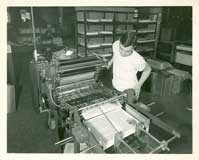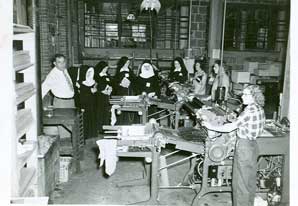Help identifying this offset press
We used these presses between 1950 and 1965 to print large type textbooks for kids with low vision here at the American Printing House for the Blind in Louisville, KY. I’ve searched on-line but can’t make a positive identication. Any ideas or thoughts where I can look? The legs are open, rather than boxed in. Unfortunately, no name plates are visible.

Offset-press-1951.jpg

Offset-press-1963.jpg
I would guess either Addressograph-Multigraph early offset duplicators (Multilith) or Davidson Offset presses of the same vintage. Here’s a photo of an early A-M press for comparison, and another of a later Davidson — visualize it with the covers removed. The legs of the Multi are different which could just be a function of different time of manufacture. Note also that the handwheels are on the opposite side (unless your photos are flipped). The Davidson plate and impression are on one large cylinder, so if the presses had large plate cylinders they were Davidsons.
Bob
Davidson offset.jpg
AM early offset press.jpg
My first impression while looking at the 1st pic was Davidson.
Not sure in looking at the second pic.
Could be an early Davidson…
Bob is correct. The Davidsons had the plate and impression on one large cylinder…making it a two cylinder press.
It’s really hard to tell from the pics.
The early Davidson feeders and the one shown in Bobs second pic were designed by the Merganthaler Co. They are identical.
I had the same feeder on 2 Davidson 241 presses that I owned at one time. I scrapped them eventually and used parts visible in the feeder elevator above in Bob’s pic to make some pretty awesome…paper towel holders.
Judging by the second photo, I’d say Nun of the above.
Rick
I looks like a Multilith press, I don’t know the model. I was offered one once. The sheet basically goes straight through the press. I only saw that one, never saw it in action, but rolled it through the printing cycle, a very unusual machine.
Paul
This is a Early Addressograph- Mutlgraph machine with a
feeder built by Davidson who supplied their feeder until
they developed their own. Saw one in about 1963 at a shop I worked in Cleveland, Ohio. It was used for imprinting and the printing head was clearly marked Multigraph and the feeder marked Davidson. Check
Multigraph history for more possible info. Also early
office machines.
Duke Sr
Further information: Enter : Multigraph with Davidson feeder 1227 in search and see ended ebay ad.
Folks:
You helped me find it! It is a Multigraph Model 2066 Duplicator, or in the same family. I found a copy of the parts manual on Amazon for sale for $21. I’ve been searching for this one for three days and your help let me identify it in an hour. The key was linking multigraph with duplicator. I knew we had bought some multigraph offset presses in the late 1950s and 60s but assumed they were the more common Multilith 1250. When I get the website finished I’ll post the link and let you critique. Quite frankly I was dreaming about offset presses and it is good to put this mystery to rest.
Mike
Multigraph 2066.jpg
I’d like to correct a statement I made that thought to be true concerning the Merganthaler Co. relationship to Davidson.
Merganthaler Co. did not design the Davidson feeder.
I had assumed that because the presses I had clearly had a Merganthaler tag on the feeders.
The feeder was designed by William Ward Davidson in 1916 and Merganthaler was manufacturing Davidsons by 1953 after a 1950 merger.
The machines I had were built in the mid-50’s.
Just wanted to clarify.
Some very interesting information here on a 1962 court case:
DAVIDSON CORPORATION
v.
The UNITED STATES.
MERGENTHALER LINOTYPE COMPANY
v.
The UNITED STATES.
http://openjurist.org/310/f2d/937/davidson-corporation-v-united-states-m...
Apparently this complaint dealt with a disputed excise tax with the Federal Government…I think.
See article 14 and 18 especially.
Article 14 specifically mentions the relationship with Davidson feeders and American Multigraph Corporation and its successor, Addressograph-Multigraph Corporation, for incorporation in their Multigraph Machines between 1924 and 1940.
I’ve learned something here and it clarifies a long held misconception.
The interesting thing about the design of a Davidson two cylinder press is that it could print letterpress. It wasn’t very good at it and never really caught on with printers…it seems.
However there was a crash numbering attachment and I’ve seen a Youtube video of one cranking out a numbering job at what seemed to be a couple thousand an hour.
Dave
Thanks for this thread! When I started in offset printing 25 years ago the presses that I cut my teeth on were a Multilith and a Davidson Perfector. It’s nice to see where these beasts came from, I was constantly grumbling at the feeder on the Davidson, the vacuum problems just about drove me crazy! I was so glad to finally say goodbye to them when I graduated to running the Harris M-110 web press! (pictured)
Thanks again for the history, I’m always learning something new here!
Steve
harris1.jpg
Steve, where does the chase go??
Ha! I never quite figured that out….this was before I was drawn over to the dark art
dick, “smear” printing requires no chase.
A Graphic Arts student asked the instructor,
“What is the difference between offset and letterpress printing?”
The instructor told him,
“When a girl kisses her handkerchief then presses it against your lips, that’s kinda like offset printing. But when she presses her lips against yours, now that’s LETTERPRESS ! “.
It could have also been a 1227 Multilith see photo I hope to attach. It took me a while to chase it down but I was sure they were Multiliths or Multigraphs.
multi1227.jpg
Great information, thanks guys! I was just offered the opportunity to buy a multilith 1250, but I wasn’t sure what the difference between offset and letterpress was, and I definitely want an impression, so thanks David Jasmund for clarifying that for me. Your description is perfect!
I worked in a shop in the ’50s with equipment would have made a great museum. C&P with a Rice feeder, 12x18 Little Giant cylinder press, along with two Davidson offset presses. These Davidson presses could have the cylinder disengaged and stepped over to allow a “lockup” in the gap of the cylinder; of Linotype slugs, up to about a post card size or an envelope corner, leaded with tapered leads to allow for the curvature of the cylinder. Numbering machines (plunger away from the gripper edge, similar I guess to what would be done on a Miehle Vertical) and small rubber plates could be used that way. Also done on a Davidson was what then was called “Dry Offset.” A wrong-read deep etch plate was run dry, that is no water, printing directly from the plate.I believe this was how the press became a perfector, printing both sides in one pass.. The Davidson is one of the primary reasons that I became a typesetter rather than a pressman. The other reason is that I could mix a POUND of color ink for a 500 business card order.
A footnote….
After all of the above, I must add…with an add-on water system, the Davidson became a Lithography Press, rather than just an offset duplicator. Capable of a high-class print job with a rich color that Multi and AB Dick couldn’t and still can’t do.